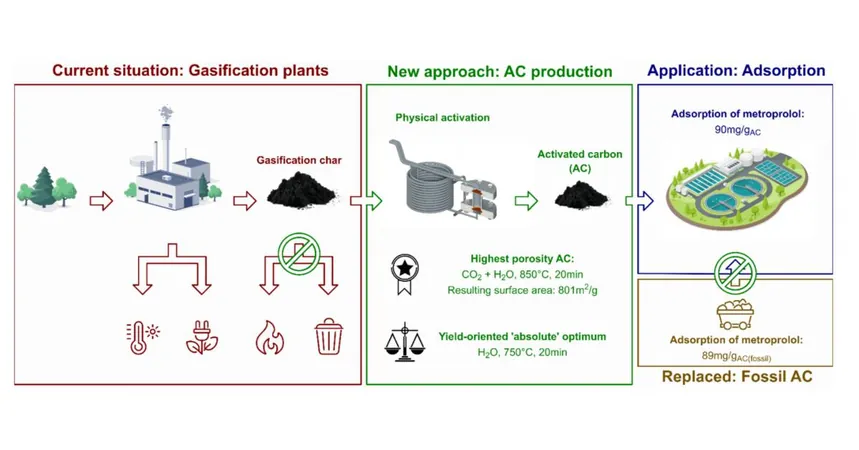
Revolutionary Waterjet Surgery for Enlarged Prostate: Enjoy Relief Without Compromising Your Sex Life!
2025-03-22
Author: Arjun
Revolutionary Waterjet Surgery for Enlarged Prostate: Enjoy Relief Without Compromising Your Sex Life!
In an exciting advancement for men's health, a new study reveals that waterjet surgery for enlarged prostates, also known as aquablation, offers impressive benefits, including greater preservation of sexual function compared to traditional laser surgeries. This cutting-edge technique was highlighted during the WATER III trial, recently unveiled at the 2025 European Association of Urology (EAU) Congress in Madrid.
The innovative aquablation procedure employs a high-pressure water jet, manipulated under robotic guidance, to precisely remove excess prostate tissue. This option is particularly advantageous for men with enlarged prostates, as it has demonstrated similar outcomes to standard laser surgery while significantly lowering the risk of retrograde ejaculation—a condition where semen is funneled into the bladder rather than being expelled through the penis. This issue, prevalent after traditional BPH surgeries, greatly impacts sexual satisfaction without posing a genuine health threat.
More than 202 men participated in the WATER III trial, all requiring surgical intervention due to benign prostatic hyperplasia (BPH)—the most common prostate condition affecting older males. With the prevalence of BPH soaring past 50% in men over 50 and exceeding 80% in those above 70, finding effective treatments is crucial for enhancing quality of life.
In the study, men were divided into two groups: one received aquablation therapy while the other underwent standard laser procedures like Holmium Laser Enucleation of the Prostate (HoLEP) or Thulium Laser Enucleation of the Prostate (ThuLEP). Results revealed an astonishing contrast in retrograde ejaculation rates—only 15% in the aquablation group versus a staggering 77% among patients receiving laser surgery. Furthermore, urinary incontinence was observed in 9% of the aquablation cohort compared to 20% in the laser cohort, indicating a noteworthy advantage for the waterjet method.
Professor Manuel Ritter, the study's lead researcher and Head of Urology at the University Hospital Bonn, emphasizes the clinical promise of aquablation, stating, "These findings underscore the potential of aquablation therapy as a strategic alternative to laser treatments for men with larger prostates. The ability to maintain ejaculatory function is invaluable for those concerned about their sex lives."
Moreover, the transition from standard procedures to aquablation may also alleviate long surgical wait times, providing a crucial solution for men suffering from urinary difficulties due to an enlarged prostate.
It is essential to note, however, that while the results are encouraging, the follow-up period for patients in the trial was only three months. Commentators, including Professor Cosimo De Nunzio from Sapienza University in Rome, advocate for longer-term studies to monitor the effect on prostate-specific antigens and overall urine quality.
In a world where men's health issues are often sidelined, this groundbreaking research shines a light on emerging surgical options that not only tackle the physical effects of conditions like BPH but also prioritize the intimate aspects of life that many fear losing. As this life-changing procedure continues to evolve, it promises to empower men to reclaim both their health and their sexual enjoyment.




 Brasil (PT)
Brasil (PT)
 Canada (EN)
Canada (EN)
 Chile (ES)
Chile (ES)
 Česko (CS)
Česko (CS)
 대한민국 (KO)
대한민국 (KO)
 España (ES)
España (ES)
 France (FR)
France (FR)
 Hong Kong (EN)
Hong Kong (EN)
 Italia (IT)
Italia (IT)
 日本 (JA)
日本 (JA)
 Magyarország (HU)
Magyarország (HU)
 Norge (NO)
Norge (NO)
 Polska (PL)
Polska (PL)
 Schweiz (DE)
Schweiz (DE)
 Singapore (EN)
Singapore (EN)
 Sverige (SV)
Sverige (SV)
 Suomi (FI)
Suomi (FI)
 Türkiye (TR)
Türkiye (TR)
 الإمارات العربية المتحدة (AR)
الإمارات العربية المتحدة (AR)